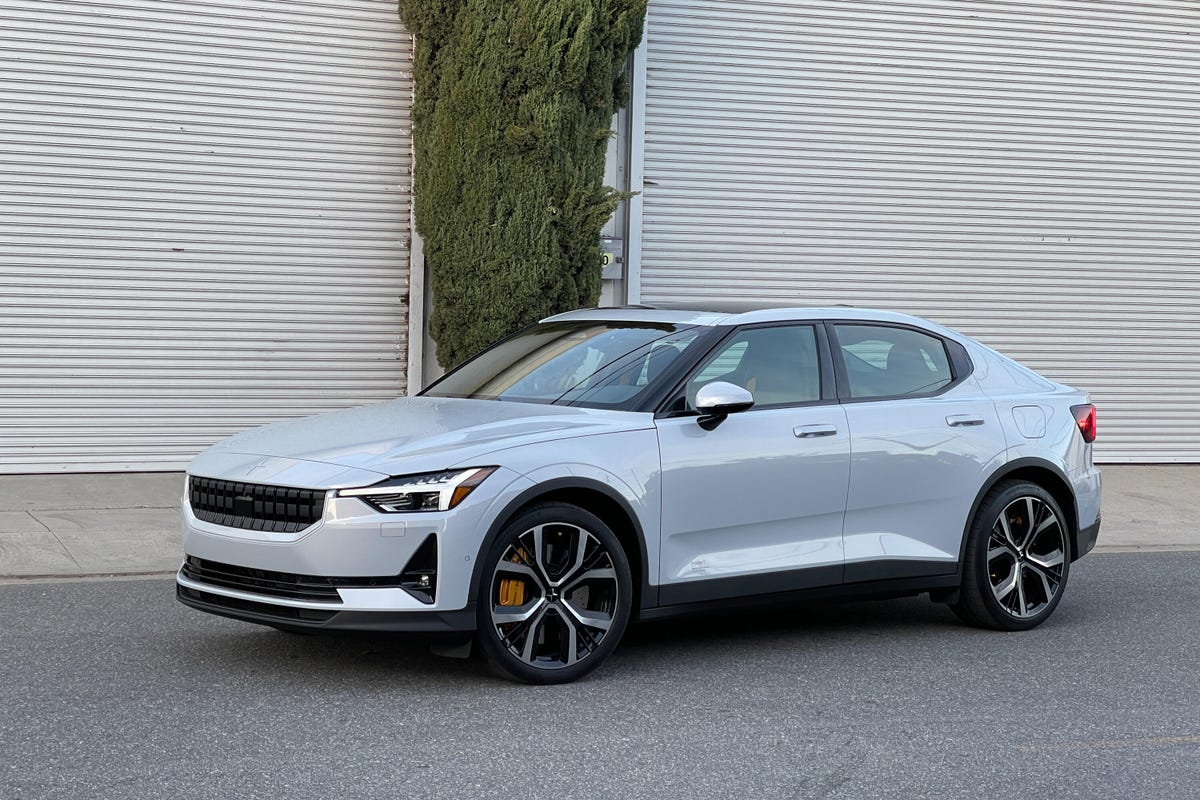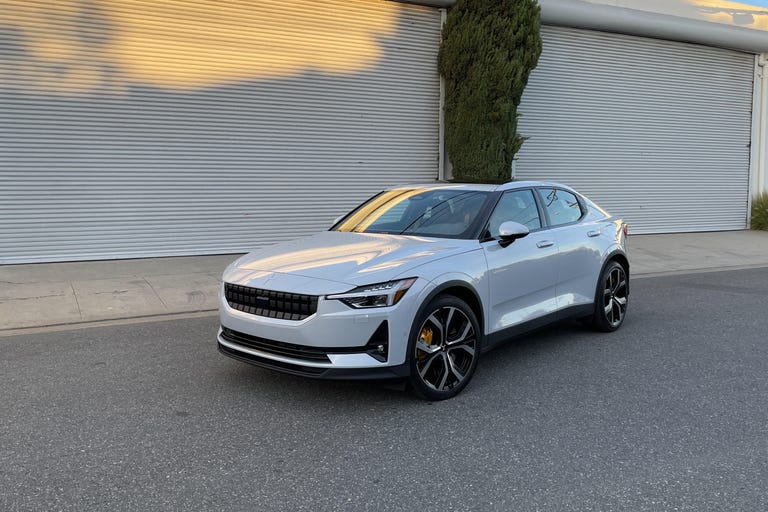 Why You Can Trust CNET
Why You Can Trust CNET 2021 Polestar 2 review: A truly cool EV
While the Polestar 2 might not have segment-leading stats, this electric hatch is extremely easy to like.

The Polestar 2 is one of the coolest EVs on sale.
Most new EVs either look too normal to stand out or too strange to entice regular consumers, but the Polestar 2 perfectly lands in that middle ground. To my eyes, this is one of the first truly cool EVs -- at least in terms of more affordable cars. And when it comes to new segments and emerging tech, sometimes being cool is the most important thing.
Like
- Fantastic stying inside and out
- Super quick and fun to drive
- Great Google infotainment system
Don't like
- Less range than Tesla
- Only comes in one expensive configuration
- Limited servicing network
A real crowd pleaser
I live in Los Angeles, where hybrids and EVs are common -- basically every other car you see is a Tesla . But the Polestar really grabs peoples' attention. Chalk some of that up to it being new and some of it to its lack of badging -- either way, most people just don't know the hell it is. They just know it's something new and cool, and want to learn more about it.
It's hard to categorize the Polestar 2. At first glance it looks like a traditional sedan, but it's got a fastback rear end with a hatch instead of a trunk. The Polestar has a higher ride height than most sedans (it's an inch taller than a BMW 3 Series but more than 4 inches shorter in length) and SUV-like body cladding, making it a bit of a pseudo-crossover. However you classify it, the Polestar 2 is an extremely handsome car, with minimal body surfacing and great proportions.
It's obvious the Polestar 2 was originally designed to be a Volvo , but that's not a bad thing. Still, lots of little details set it apart from other Volvos, like the blocky patterned grille and full-width LED taillight strip. The only badges on the car are body-color Polestar logos on the hood and trunk, as well as subtle stickers on the front doors that denote the model name, battery pack size and power output.
The Volvo influence is obvious in the 2's interior, but Polestar's designers really turned the specialness up a notch or two. My test car has the Slate color scheme, which features vegan WeaveTech surfaces that feel like a high-end windbreaker and black ash wood trim. There's a good amount of head- and legroom for front and rear passengers and the cabin feels airy thanks to the huge standard panoramic sunroof. I wish there was a sunshade for the roof, though, as direct sunlight can still be annoying despite the tinted glass. Another major downside is a lack of storage up front, with only one usable cupholder in the center console (there's another under the center armrest) and fairly small door pockets. Still, the overall vibe is very Swedish high-end furniture/audio store and it genuinely feels premium.
The Polestar's Google-based infotainment system is one of our favorites.
OK, Google, you rule
The Polestar 2 is the first production car to use Google's Android Automotive infotainment tech and even for a staunch iPhone user like myself I think it's easily one of the best systems on the market. (Don't worry, Apple CarPlay functionality is coming and I don't even miss it during my time with the car.) The system looks fantastic and the 11-inch screen is super quick and snappy, plus it's easy to log into my Google account via QR code and download apps like Spotify from the Google Play store. There aren't too many apps yet and missing ones include Audible and some major podcast platforms, but they're coming. The Google Assistant voice commands work well too and it can even control things like the seat heaters. The only physical controls are a volume knob and buttons for the heated windshield and rear window, meaning even climate controls are accessed through the screen, but that's easy to get used to.
The best part of the Android system is that Google Maps is the native navigation. I typically gravitate towards using Google Maps through CarPlay over any built-in nav and it looks even sharper on the Polestar's display -- there's even a nearly full-screen view for Maps in the 12.3-inch digital gauge cluster. The Google tech has some nice EV-specific features, like showing the estimated range and charge you'll have at the end of a set journey and providing an info-filled list of charging stations. I do wish you could see a satellite map view, though.
Shirking the EV norms
For now, every Polestar 2 comes the same way; there's one battery pack size and one motor configuration. There's an electric motor at each axle for a combined output of 408 horsepower and 487 pound-feet of torque, with all-wheel drive as standard. With a 0-to-60-mph time of 4.5 seconds the Polestar 2 is damn quick. Launches push you back in your seat and the performance doesn't seem to fade after multiple goes. There's no sport mode or adjustable power setting, so you've always got the full amount of torque no matter what. I do like that you can turn the idle creep function on and off, too -- I prefer to leave it off like a brake hold feature.
There are three settings for the steering, the firmest of which is my favorite. It's really nicely weighted, direct and actually offers a good amount of feedback, which is not the norm for EVs. The Polestar's chassis is great too and the car feels a lot more nimble than its nearly 5,000-pound weight suggests. An ESC Sport mode reduces the intervention of the stability control, but it doesn't make a massive difference in the dry. Overall, the Polestar 2 is just as fun to drive in the twisties as it is around town. Impressive.
That subtle styling packs a major punch.
But the best part of the Polestar 2 isn't how it launches or how it corners, it's how it stops. The 2 has a regenerative braking system that affords true one-pedal driving and once you've experienced an EV with a good one-pedal system, it's hard to go back to anything else. The Polestar lets you select between having the regen fully off, having it in a low setting that won't bring the car to a complete stop, or keeping it in the standard mode. Keeping the Polestar in the standard mode the whole time, I maybe touch the brake pedal half a dozen times over the course of a week of testing. Even during a very spirited drive on some canyon roads, the regen is so strong and easy to regulate that I never have to tap the brakes.
You can add a $5,000 performance package, but honestly, I wouldn't. While I love the design of the 20-inch wheels and the gold seatbelts, the Polestar 2's regenerative braking makes the performance pack's upgraded front Brembo brakes unnecessary. And as cool as the manually adjustable Öhlins dampers might seem, they're annoying to adjust and make the car ride worse than with the standard setup. Plus, if you really want bigger wheels, a set of 20-inchers with a sweet 4-spoke design is available for $1,200.
Standard active-safety features include Volvo's Pilot Assist system (adaptive cruise control with steering assist), automated emergency braking, blind-spot monitoring, rear cross-traffic assist, lane-departure warning, lane-keeping assist, a 360-degree camera and parking sensors. Every Polestar 2 also comes with heated front and rear seats, a heated steering wheel, heated windshield wipers, active LED headlights, a Harman Kardon sound system, ambient interior lighting and a wireless phone charger.
The Polestar 2's interior reminds me of high-end furniture.
Let's talk about range
The EPA says the Polestar 2 has a range of 233 miles per charge and while I never fully charge or fully deplete the battery pack, the car's estimated range readout seems accurate if not a little conservative. It only gives the range in 5-mile increments, which I think is fine -- I'm never going to get close enough to empty for a super-precise readout to really matter anyway. The Polestar's range is way more enough for me and it certainly is enough for the majority of consumers, especially those with short commutes. But I wouldn't hesitate to take it on a long highway trip that would require charging; Polestar says the 2 can gain an 80% charge in just 40 minutes on a 150-kilowatt DC fast charger.
There's a lot of public charging in Los Angeles, but nearly every time I charged it was at the same location close to my apartment, so I didn't have to deal with a lot of searching for stations that aren't either broken or occupied. (There was a massive puddle of oil on the ground next to my parking spot the first time I charged, go figure.) While Polestar has no fast-charging network of its own like Tesla, you can charge it up at third-party stations like those from Electrify America and EVgo. Polestar also recently announced a partnership with ChargePoint in which the companies will launch an in-car app and expand access to all of ChargePoint's 130,000 chargers.
Rejoice! It's a hatchback!
One configuration fits all
The Polestar 2 starts at $61,200 including destination, but before any incentives. It's eligible for a federal $7,500 tax credit, which brings the price down to $52,400. With $1,200 Snow paint and the $5,000 performance pack, my test car is $67,400. The only option left on the table is the $4,000 ventilated leather interior that would bring the price to $71,400. So yeah, the Polestar is quite pricey, even among other premium EVs. (Cheaper models with fewer standard features will eventually arrive, though no details have been announced yet.)
The easiest comparison to draw is with the Tesla Model 3 , as it's the only other premium electric sedan in the same size class as the Polestar. The all-wheel-drive Long Range Model 3 starts at $46,690 before any incentives and offers slightly quicker acceleration and a much longer range (353 miles). Then there's the $54,690 Model 3 Performance, which has a 315-mile range and will hit 60 mph a full second quicker than the Polestar. In terms of performance and value for money, the Model 3 creams the Polestar 2.
I don't want the Tesla, though. The Polestar 2 is more enjoyable to drive, better to look at and way nicer inside, plus I prefer its tech and the hatchback rear end. And most importantly (at least to me), the Polestar is just more interesting. Even if Teslas weren't so common where I live, I'd still want to be seen in the Polestar. Driving it feels like I'm at the cutting edge of the industry.
The Polestar 2 is currently available to order online, with test drives, delivery and servicing handled by the brand's Spaces showrooms. As of right now there are only a few, mostly in California with one in Denver and another in New York City. But Polestar promises that 15 more showrooms will open by the end of 2021 in places like Boston, Seattle, Detroit and Miami. If you're interested in a premium electric car and have a Polestar Space near you, I highly recommend checking it out. You might end up the coolest person in your neighborhood.


